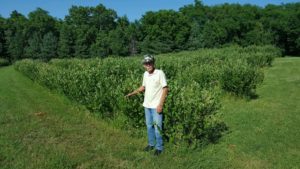
The Brockmans found out about the USDA Farm Service Agency’s (FSA) Noninsured Crop Disaster Assistance Program (NAP) during a growers meeting. They contacted their county office and enrolled their aronia berries in the program as beginning farmers.
By Lauren Moore, FSA Public Affairs Specialist
Roger Brockman, owner of Fox Run Berry Farm in Gretna, Nebraska, has had a long career in bug extermination.
While he’s still in the extermination business, Roger and his wife, Sandra, began a new business venture in 2010.
“We had unused land that was planted with just grass,” he said. “My wife was told about the aronia berry from a massage therapist. They were talking about how we wanted to do something with our land and they gave her a brochure about the berry.”
Roger began looking into the crop six months later to learn more about it. Aronia berries are a perennial crop, native to some of the Eastern and Midwestern states.
“We decided to put some bushes in the ground and see what happens,” Roger said. “We did this originally as a sideline project for a supplemental income. After the first couple of harvests, we decided to add more bushes. We put our first bushes in the ground in 2010. It normally takes three to four years after planting before you get a crop. Two years ago, we put 1,400 more bushes in the ground.”
Fox Run Berry Farm is a part of a group of organic growers who grow aronia berries for an intermediate processor, Sawmill Hollow Family Farm.
“We couldn’t find a market for our berries, so we went up to Sawmill Hollow’s North American Aronia Berry Festival in Missouri Valley, Iowa,” Roger said. “We talked to the Pittz family, the owners and operators of the farm, and joined their group of growers.”
Roger found out about the USDA Farm Service Agency’s (FSA) Noninsured Crop Disaster Assistance Program (NAP) during a growers meeting at Sawmill Hollow. NAP provides financial assistance to producers of noninsurable crops when low yields, loss of inventory or prevented planting occur due to natural disasters.
The Brockmans contacted their county office and enrolled their aronia berries in the program as beginning farmers. There are special provisions for new and beginning farmers and ranchers under NAP. A beginning farmer or rancher is a person or legal entity who has not operated a farm or ranch for 10 years and materially and substantially participates in the operation.
“We looked into NAP three years ago,” he said. “We haven’t needed to use the benefits of NAP so far. Hopefully it will stay that way.”
Roger says the most rewarding part about being involved with agriculture is working with the land, planting and watching their yield grow. While dealing with the weather is one of his least favorite parts, in the event of a storm, the Brockmans know FSA has them covered.
Deadlines to apply for NAP coverage vary by state and crop. Contact your local FSA office to schedule an appointment to enroll. To find your local USDA Service Center visit offices.usda.gov.





